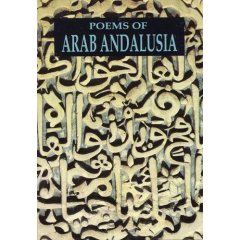"Poems of Arab Andalusia" translated by Cola Franzen

Posted by J
Poems of Arab Andalusia
Translated by Cola Franzen from the Spanish versions of Emilio Garcia Gomez
http://www.amazon.com/Poems-Arab-Andalusia-Cola-Franzen/dp/0872862429/sr=8-1/qid=1165764182/ref=pd_bbs_sr_1/104-5253685-8654347?ie=UTF8&s=books
This is a truly magical little book. Poetry was an art form in which the Andalusian (Spanish) Arabs excelled. Kings, ministers, scientists, warriors, farmers, and pure poets alike all excelled and it was said that the most common of folks could voice their daily complaints, praises, and musings in poetry. The walls of the Alhambra itself in Granada are lined with the verse of the royal minister Ibn Zamrak.
This book represents an English rendering of one of the first "recoveries" of that Arabic poetic legacy into the languages of Europe. In the 1920s a Spanish Arabist by the name of Emilio Garcia Gomez came upon (in Cairo) a 13th century collection of Andalusian poetry compiled by one Ibn Said. He went about translating and publishing these in Spanish hoping to provide a small example of the richness of Arab Andalusian poetry. He thought it a small work, but a generation of Spanish poets hungry for new inspiration was enthralled by what they read. The so-called Generation of 27 in Spain was heavily influenced by this little work of translation "for being at one and the same time very old and very new".
But to take it back to its original: Ibn Said living in the 13th century was looking back to several centuries of the best Arab poets of the peninsula. This collection, now available in English, does indeed provide real gems, with a richness of metaphor and attention to minute detail that in many ways mirrors the Alhambra itself - i.e., an ability to take a wide expanse (i.e., the field of Arab poetry) and then drill down into small corners of meaning to find rich and deep meaning (ink on paper, the curves of one's love, a cup of wine, a lance in the midst of battle, etc.).
What made it even more magical to me personally was as we recently travelled through Al-Andalus to be able to pause overlooking Seville or Cordoba or Granada and then open this book up and read the words which the poets of a millenium ago wrote in those very locations. The translator provides the names and dates of each of these poets, and my own historical background knowledge let me know a little something more about the conditions they lived in. King Al-Mu'atamid of Seville writing from Almoravid exile in Morocco, Cordoban poets writing in the heyday of the Caliphate and later in the turmoil of the Taifa kingdoms or the last troubled days before the fall to the Christians, Valencian poets writing of the beauty of the land shortly after intensive agriculture had taken root in the region, etc.
The translations of the poems, being as they are English translated from Spanish from the Arabic, undoubtedly lose much of the original. But I must say as others have that I still find them enthralling. The imagery is vivid and the language highly readable. Something of the rhythm still survives even if all the rhyme can not. If other books I have read recently focused so much on politics that they missed the culture, this is a wonderful nugget of that culture. Put it together with the imagery of Islamic art of Andalusia that is widely available, and one can start to get a decent feel for the rich culture which flourished off and on for almost 8 centuries in Islamic Spain/Al-Andalus.

